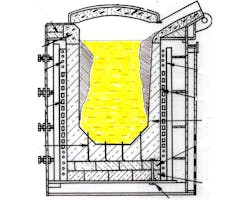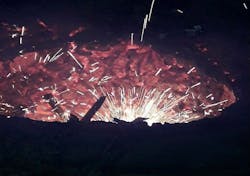Global Impact of Redux Fluxes to Reduce Slag Build-Up
During the past 40 years, the melting methods and associated molten metal-handling systems used by U.S. foundries have changed significantly. Further, the quality of metallic scrap and other iron-unit feed stocks has steadily deteriorated. The result: Increased slag generation and slag related melting problems have become widespread issues in recent years. A search of the foundry technical literature about slag control and build-up from the past 40 years finds only a handful of articles.
Because most iron foundries use silica-based refractories in their induction melting operation, they have been reluctant to add fluxes. Fluxes are used extensively in the basic steel industry, where the use is considered a science. For foundries, however, historically there has been a reluctance to use fluxes.
Improper use of fluxes can rapidly erode refractory furnace linings, especially if potent fluxes are used. More often, an operator error causes problems with fluxes. The saying of "if a little works well, then a lot should work better" doesn't necessarily apply. Doubling or tripling the amount of recommended flux additions can reduce lining life, especially with highly reactive fluxes. Meanwhile, refractory suppliers have convinced foundrymen that any use will greatly reduce refractory life, often without having any knowledge of the chemistry or potency of the flux.
Now, newly engineered fluxes can extend the refractory life of coreless induction furnaces by as much as 60%, extend the service life of pouring ladles, and significantly reduce the incidence of casting slag and/or dross inclusions.
The formation of slags in the melting of ferrous metals in the foundry is inevitable. The composition of slag varies with the process used and the type of iron or steel being melted. The cleanliness of the metallic charge, often consisting of sand-encrusted gates and risers from the casting process, or rust and dirt encrusted scrap, significantly affects the type of slag formed during the melting operation.
Additional oxides or nonmetallic compounds also can be formed when liquid metal is treated with materials to remove impurities (deoxidation) or to change the chemistry of the system (inoculation and nodulizing). Because these oxides and non-metallics are not soluble in iron, they float in the liquid metal as an emulsion. This emulsion of slag particles remains stable if the molten iron is continuously agitated, as in the case of the magnetic stirring inherent to induction melting.
When used with each charge of scrap, a properly engineered flux will cleanse the metal by flushing microscopic, emulsified slag particles out of the melt and assisting in the flotation to the molten metal surface, where the slag must be removed. Redux flux additions will prevent slag deposits on the sidewalls by removing these emulsified non-metallics. The formation of build-up on refractory walls is a classical nucleation and growth process. Shortly after the first liquified slag phases precipitate as a thin solid film or substrate on a refractory surface, build-up proceeds quite rapidly. Then, the liquified slag phases can easily grow on the deposited build-up since the initial build-up phase is crystallographically similar to the liquid glass phase attempting to come out of solution. Thus, preventing this first initial build-up is imperative in extending the refractory life.
For foundries operating induction melting and pouring systems there has long been a negative association with the use of fluxes for ferrous metal production. Silica-based refractories commonly used in induction furnaces, are prone to chemical attack from fluxes. In many ferrous melt shops, it’s common to add mixtures of lime/fluorspar (CaCO3/CaF2), for desulphurization, phosphorus reduction, deoxidation, coke cleansing, or to improve metal cleanliness. Many of these melting furnaces might have been removed from service prematurely because of the inability to remove stubborn slag and insoluble build-up effectively and safely from the sidewalls. However, recent changes in flux formulations, eliminating chlorides and fluorides, have achieved successes in induction melting and pouring operations while being environmental conscious.Figure 1 is a typical example of what frequently happens when poor quality, dirty, sand-encrusted charge materials are used.
This type of build-up was typically observed at International Foundry A is shown in Figure 2.
Foundry “A”’s 7 metric ton charge consists of 56% steel, 10% pig iron, and 34% foundry returns. The coreless induction furnace is lined with a silica refractory. Tapping temperature from the furnace is 2,789oF (1,532oF.) Slag build-up has been a recurring problem for Foundry A.
The build-up caused increased melting costs from the additional electrical requirements, reduced furnace capacity, loss of melting production, and damage to refractory walls from chipping and descaling. To eliminate these issues, Foundry A tested a relatively new, non-fluoride flux, Redux EF40L.
For the initial trials of Redux EF40L, 0.05% Redux EF40L (7.7 lbs. or 3.5 kgs ) was added to the furnace in two increments. Half of the Redux flux addition was added once the initial 50% of the charge was melted, and the remaining Redux was added in the next back charge.
After just one Redux addition, a significant amount of slag adhering to the furnace refractory was removed simply by skimming it from the surface. After two more treatments, all remaining adhering slag was removed and the furnace walls were clean, as shown in Figure 3. The overall positive impact of the three Redux EF40L flux treatments appeared to remove all slag build-up and return the furnace capacity to 100%.
Eliminating slag build-up from the furnace walls has resulted in the following benefits:
• Using Redux EF40 has reduced “bridging” tendencies due to cleaner refractory walls
• Reduced power consumption during each melt
• Hourly maintenance from scraping was greatly reduced
• Consistent furnace capacities and charge weights
• Improved “electrical coupling” was observed with improved temperature control
• No adverse effects on the dry vibratable silica refractory linings
Currently, mild fluxes like Redux EF40 can increase service life of ferrous induction melting furnaces, while preventing insoluble build-up deposition. There are multiple case histories of success in coreless induction furnaces, channel induction furnaces, press pouring furnaces, and ladle applications. Now, iron foundries do not need to fear using fluxes; they just need to use them properly, as prescribed by the manufacturer.
Rod Naro is president and CEO, and David C. Williams is v.p. - Technology of ASI International Ltd. Visit www.asi-alloys.com
About the Author
Dr. R. L. (Rod) Naro and D. C. Williams
Rod Naro is president and CEO, and David C. Williams is v.p. - Technology of ASI International Ltd. Visit www.asi-alloys.com



